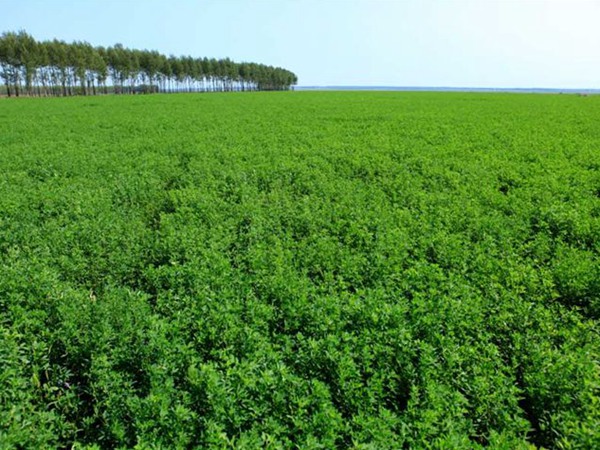Micayla H West, William B Smith, Adam Rabinowitz, Kim K Mullenix, Leanne L Dillard
 Dual-purpose wheat
(Triticum aestivum L.) systems increase farm sustainability by diversifying
on-farm income. While these systems are common in the
Southern Great Plains of the U.S., they are not often utilized in the
Southeast. This study aimed to evaluate pre- and post-grazing herbage mass
(HM) of four winter wheat varieties managed under a dual-purpose grazing and
grain production system. The wheat varieties evaluated were generic feed-type
wheat (unknown variety blend, Feed), seed-type wheat ‘GA Gore’ (Seed) and two
forage-type varieties, ‘AGS 2024’ (AGS) and ‘Pioneer 26R41’ (Pioneer). The experiment was a randomized complete
block design (n = 4) conducted during the winter of 2021 and 2022. Three
grazing frequencies were utilized: an ungrazed control (NG), low frequency (LF)
and high frequency (HF) grazing schedule. Low frequency plots received monthly
grazing in January and February while HF treatments received a third grazing in
March. Plots were grazed with 20 cow-calf pairs (Bos taurus) until an even
defoliation height of 10 cm was achieved. Herbage mass was determined using three
0.1m2-quadrats per plot and clipped to a 10 cm stubble height before
(PreG) and after (PostG) each grazing event. Forage samples were then dried at
45°C for 72 h. Data were analyzed using PROC GLIMMIX of SAS (SAS Inst., Cary,
NC) with forage sample date as a repeated measure. Differences were declared at
P < 0.05. Final biomass, including stems, chaff, and grain, was greatest for
Pioneer but was not different from AGS or Feed (4,112 kg/ha and 4,003 kg/ha; P ≤
0.94). Before grazing, AGS herbage mass (2,646 kg/ha) was greater (P ≤ 0.03) than all other varieties. There was an interaction (P ≤ 0.01) of variety and grazing frequency for Pre-G herbage mass. Compared
with all other varieties, AGS had greater ADF (24.93%; P < 0.01) and least
TDN (72.49%: P < 0.01). Forage nitrate-nitrogen was not different (P ≥ 0.49) among all varieties or grazing frequencies (157.73 ppm). Across
grazing frequencies, Pioneer had greater final grain yield (3,619.43 kg/ha; P
< 0.01) with Seed having the least (1,272.12 kg/ha; P < 0.01). These results indicate that common Southeastern wheat
varieties can be successfully utilized in a dual-purpose management system;
however, grazing frequency should be monitored to prevent grain yield losses.
Dual-purpose wheat
(Triticum aestivum L.) systems increase farm sustainability by diversifying
on-farm income. While these systems are common in the
Southern Great Plains of the U.S., they are not often utilized in the
Southeast. This study aimed to evaluate pre- and post-grazing herbage mass
(HM) of four winter wheat varieties managed under a dual-purpose grazing and
grain production system. The wheat varieties evaluated were generic feed-type
wheat (unknown variety blend, Feed), seed-type wheat ‘GA Gore’ (Seed) and two
forage-type varieties, ‘AGS 2024’ (AGS) and ‘Pioneer 26R41’ (Pioneer). The experiment was a randomized complete
block design (n = 4) conducted during the winter of 2021 and 2022. Three
grazing frequencies were utilized: an ungrazed control (NG), low frequency (LF)
and high frequency (HF) grazing schedule. Low frequency plots received monthly
grazing in January and February while HF treatments received a third grazing in
March. Plots were grazed with 20 cow-calf pairs (Bos taurus) until an even
defoliation height of 10 cm was achieved. Herbage mass was determined using three
0.1m2-quadrats per plot and clipped to a 10 cm stubble height before
(PreG) and after (PostG) each grazing event. Forage samples were then dried at
45°C for 72 h. Data were analyzed using PROC GLIMMIX of SAS (SAS Inst., Cary,
NC) with forage sample date as a repeated measure. Differences were declared at
P < 0.05. Final biomass, including stems, chaff, and grain, was greatest for
Pioneer but was not different from AGS or Feed (4,112 kg/ha and 4,003 kg/ha; P ≤
0.94). Before grazing, AGS herbage mass (2,646 kg/ha) was greater (P ≤ 0.03) than all other varieties. There was an interaction (P ≤ 0.01) of variety and grazing frequency for Pre-G herbage mass. Compared
with all other varieties, AGS had greater ADF (24.93%; P < 0.01) and least
TDN (72.49%: P < 0.01). Forage nitrate-nitrogen was not different (P ≥ 0.49) among all varieties or grazing frequencies (157.73 ppm). Across
grazing frequencies, Pioneer had greater final grain yield (3,619.43 kg/ha; P
< 0.01) with Seed having the least (1,272.12 kg/ha; P < 0.01). These results indicate that common Southeastern wheat
varieties can be successfully utilized in a dual-purpose management system;
however, grazing frequency should be monitored to prevent grain yield losses.
2023,JAS,101:Issue Supplement_1
https://doi.org/10.1093/jas/skad068.060
Registration hotline: 021-57634675
fax: 021-57632800
Copy right : 上海亘泰实业集团
Collaboration & Sponsorship: 021-57634938 57631012
ASASHotline:021-67868428
Site Map | CNZZStatistics
address:Shanghai songjiang jiuting town nine new highway 90 lane 3 nine new commercial building 15 floor

WeChat ID:asaschina
The pig nutrition international BBS CSIS